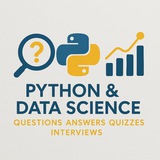Python.pdf
488 KB
👨🏻💻 An excellent note that teaches everything from basic concepts to building professional projects with Python.
➖➖➖➖➖➖➖➖➖➖➖➖➖
Please open Telegram to view this post
VIEW IN TELEGRAM
❤2🔥1
KMeans Interview Questions
❓ What is the primary goal of KMeans clustering?
Answer:
To partition data into K clusters based on similarity, minimizing intra-cluster variance
❓ How does KMeans determine the initial cluster centers?
Answer:
By randomly selecting K data points as initial centroids
❓ What is the main limitation of KMeans regarding cluster shape?
Answer:
It assumes spherical and equally sized clusters, struggling with non-spherical shapes
❓ How do you choose the optimal number of clusters (K) in KMeans?
Answer:
Using methods like the Elbow Method or Silhouette Score
❓ What is the role of the inertia metric in KMeans?
Answer:
Measures the sum of squared distances from each point to its cluster center
❓ Can KMeans handle categorical data directly?
Answer:
No, it requires numerical data ; categorical variables must be encoded
❓ How does KMeans handle outliers?
Answer:
Outliers can distort cluster centers and increase inertia
❓ What is the difference between KMeans and KMedoids?
Answer:
KMeans uses mean of points, while KMedoids uses actual data points as centers
❓ Why is feature scaling important for KMeans?
Answer:
To ensure all features contribute equally and prevent dominance by large-scale features
❓ How does KMeans work in high-dimensional spaces?
Answer:
It suffers from the curse of dimensionality, making distance measures less meaningful
❓ What is the time complexity of KMeans?
Answer:
O(n * k * t), where n is samples, k is clusters, and t is iterations
❓ What is the space complexity of KMeans?
Answer:
O(k * d), where k is clusters and d is features
❓ How do you evaluate the quality of KMeans clustering?
Answer:
Using metrics like silhouette score, within-cluster sum of squares, or Davies-Bouldin index
❓ Can KMeans be used for image segmentation?
Answer:
Yes, by treating pixel values as features and clustering them
❓ How does KMeans initialize centroids differently in KMeans++?
Answer:
Centroids are initialized to be far apart, improving convergence speed and quality
❓ What happens if the number of clusters (K) is too small?
Answer:
Clusters may be overly broad, merging distinct groups
❓ What happens if the number of clusters (K) is too large?
Answer:
Overfitting occurs, creating artificial clusters
❓ Does KMeans guarantee a global optimum?
Answer:
No, it converges to a local optimum depending on initialization
❓ How can you improve KMeans performance on large datasets?
Answer:
Using MiniBatchKMeans or sampling techniques
❓ What is the effect of random seed on KMeans results?
Answer:
Different seeds lead to different initial centroids, affecting final clusters
#️⃣ #kmeans #machine_learning #clustering #data_science #ai #python #coding #dev
By: t.iss.one/DataScienceQ 🚀
❓ What is the primary goal of KMeans clustering?
Answer:
❓ How does KMeans determine the initial cluster centers?
Answer:
❓ What is the main limitation of KMeans regarding cluster shape?
Answer:
❓ How do you choose the optimal number of clusters (K) in KMeans?
Answer:
❓ What is the role of the inertia metric in KMeans?
Answer:
❓ Can KMeans handle categorical data directly?
Answer:
❓ How does KMeans handle outliers?
Answer:
❓ What is the difference between KMeans and KMedoids?
Answer:
❓ Why is feature scaling important for KMeans?
Answer:
❓ How does KMeans work in high-dimensional spaces?
Answer:
❓ What is the time complexity of KMeans?
Answer:
❓ What is the space complexity of KMeans?
Answer:
❓ How do you evaluate the quality of KMeans clustering?
Answer:
❓ Can KMeans be used for image segmentation?
Answer:
❓ How does KMeans initialize centroids differently in KMeans++?
Answer:
❓ What happens if the number of clusters (K) is too small?
Answer:
❓ What happens if the number of clusters (K) is too large?
Answer:
❓ Does KMeans guarantee a global optimum?
Answer:
❓ How can you improve KMeans performance on large datasets?
Answer:
❓ What is the effect of random seed on KMeans results?
Answer:
#️⃣ #kmeans #machine_learning #clustering #data_science #ai #python #coding #dev
By: t.iss.one/DataScienceQ 🚀
